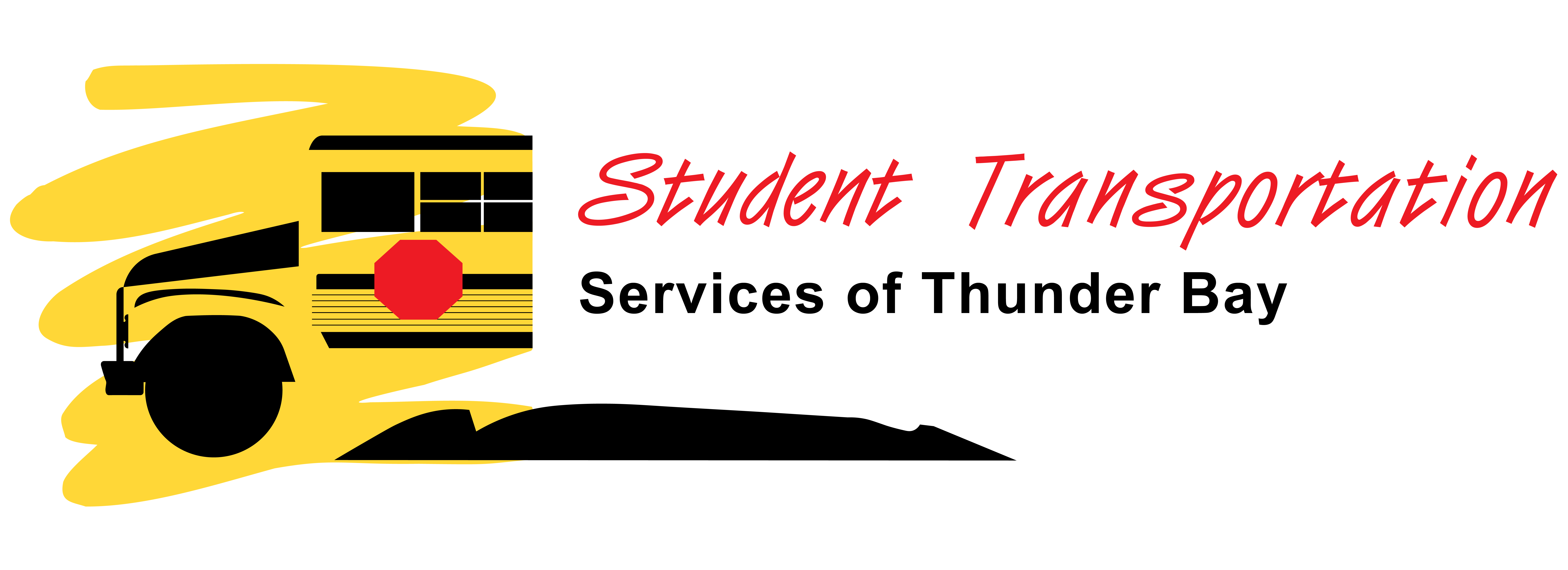Driver Responsibilities
Drivers should have a positive attitude and a general liking for children. They should believe in a practice of impartiality and fairness to all, with special privileges to none. A driver who consistently demonstrates his/her devotion to duty will find that student passengers more readily meet their obligations. By accepting the responsibility of transporting students to their respective schools, drivers have also assumed their safety. Drivers should abide by the policies of the District School Boards, schools and school bus operators. Operators will ensure that drivers will adhere to the following rules.
1. Driver and Student
- Students must be let off at the stop designated by STSTB unless provided with a Temporary Transportation form approved by STSTB.
- Revision of routes or stops are only to be made with the authority of Student Transportation Services of Thunder Bay.
- Requests from parents to change stops, or to make any other special arrangements, are to be directed to School Principals and STSTB.
2. Establishing Rules of Conduct
- Students are expected to board the bus promptly and carefully, to take their seats and to make sure that book bags and other belongings are not in the aisle.
- Students must remain seated and facing forward while the bus is in motion.
- Children may speak and chatter among themselves quietly, but crying out or shouting is not allowed.
- Passengers are not allowed to distract the driver.
- Passengers must not open windows without permission.
- Passengers are not allowed to throw things about, or from the bus.
- Fighting or horseplay is not allowed.
- All student codes of conduct must be followed without exception. If a student does not observe the codes of conduct, the driver or bus operator shall notify the principal as soon as possible, with a Student Behavior Report.
- Drivers are to comply with Bill 157 Education Amendment Act - Keeping Our Kids Safe at School. To report to the principal if they become aware that a student may have engaged in an activity for which the student must be considered for suspension or expulsion (done as soon as reasonably possible) Report to be submitted on Safe Schools Incident Reporting Form.
3. The Driver
- Shall not:
- suspend a student’s bus riding privileges
- put a student off anywhere except their designated stop or school
- administer any form of punishment
- ridicule students or embarrass them in front of their peers
- lose their temper - bus drivers shall demonstrate they are leaders and professionals
- Shall maintain good behavior and conduct of students in transit.
- Shall carefully observe the number of students getting off the bus and account for the safety of all before proceeding further.
- Must ensure a visible parent or guardian or a responsible sibling or caregiver is available for all Kindergarten students.
- Is responsible for designing a seating plan to ensure the safety and proper loading of students. This should be done in consultation with the school principal.
4. Route
- Any changes of assigned routes may be made only with the approval of STSTB . Emergency situations requiring a detour are acceptable, but should be reported immediately to the operator by radio.
- Dangerous situations such as a difficult turn-around, construction zones, washouts, narrow roads, bad turns or stops, etc., must be reported to the operator who will inform STSTB immediately.
- Elementary students transferring from one bus to another must not be left unattended. Transfers must be made at authorized transfer points only.
- Overloaded buses must be reported to the operator immediately by radio. Buses will not proceed if overloaded.
- Elementary students will not be unloaded at the school until a supervisor is visible.
- The driver should notify operator of any students who have not been riding for 20 consecutive school days or more (“no shows”).
- The driver must ensure proper route identification, designated by STSTB, are on buses at all times.
- Be on time.
5. Driver Responsibility for Loading and Unloading
The time of greatest danger for students occurs when the bus is stopped for loading and unloading.
- Be courteous and considerate to motorists and allow them to pass whenever possible before stopping and after discharging passengers.
- Be in neutral and the emergency brake engaged when loading or unloading students.
- Stop on the traveled portion of the road while loading or unloading, except where school bus loading zones are designated.
- Prior to stopping, activate the alternating flashing amber advanced warning lights and, once at a complete stop, deactivate the flashing amber lights while simultaneously activating the alternating flashing red stop lights and stop arm and leave activated until all students are safely loaded/unloaded, and across the road.
- Not proceed until all students are safe on the side of the road and clear of the bus.
- Ensure students are seated before bus is set in motion.
- Make sure, when students must cross the road at any point, that all traffic in both directions has stopped, and then motion the students to cross the road in front of the bus. Students should be visible to the driver. Students should be visible to the driver and at least 3 meters (10 feet) in front of bus when crossing.
- Ensure that students are not picked up or discharged on a steep grade, a blind curve, or the brow of a hill, or at any other unsafe locations. Suggested visibility in both directions at any stop is 150 meters (500 ft.).
- Make sure that children get off at their own bus stop.
- Greet children (by name if possible) and say goodbye.
- At the completion of every run, complete a child check, checking under every seat,
6. Driver Responsibility for Vehicle
- Must observe the speed limit at all times, and adjust speed of bus when encountering hazardous road conditions and inclement weather.
- Must make the required walk around inspection (as specified by M.T.O.) of each unit before departure, and spot checks prior to each trip, with a final inspection at the end of each run.
- The bus is to be clean and swept out at all times.
- Bus doors and emergency windows are to be closed at all times while the bus is in motion.
- When approaching railroad crossings, the driver must bring the bus to a complete stop in the prescribed manner, open the door, look both ways, listen for oncoming trains and, when all is clear, proceed with caution.
- Must immediately report all accidents involving buses or students to the police and the operator, by phone or radio and if possible the Principal as soon as arriving at the school. In the case of serious accidents, or when the degree of injury is in doubt, the appropriate medical assistance should be obtained as soon as possible. STSTB must receive a phone call regarding the information about the accident by the Operator as soon as possible and then a written report must be submitted to the office by the Operator within 24 hours of the incident.
- In the case of an emergency where the driver and passengers must evacuate the bus, the driver must turn off the engine, remove the ignition keys, engage the emergency brake, put on emergency four-way flashers, and set flares if necessary.
- Must not fill fuel tanks when students are in the bus. The driver shall ensure that the bus has sufficient fuel before departing on a trip.
- Must never operate a school bus while under the influence of alcohol or an intoxicant, or drugs of any kind.
- Smoking (including e-cigarettes/vaping) is not permitted on the bus at any time. Eating and/or drinking are not permitted on the bus.
- Must not permit non-students or unauthorized persons to ride the bus while students are being transported without written authority from STSTB.
- Must not bring animals on the bus.
- Above all, the driver must obey all traffic signs and rules as outlined by the M.T.O. and in provincial statutes and regulations.
- Sudden stops by the school bus should be avoided. The driver shall keep far enough back of the vehicle ahead to allow a safe braking distance in the event the vehicle makes a sudden stop. Bus drivers should activate their warning flashers to indicate a stop in sufficient time to allow traffic ahead and behind to come to a safe stop.
- The driver will radio in before any unscheduled backing up of the bus. The driver must never back up in a loading zone
7. Radio Procedures for Drivers
- Communication radios must be on at all times.
- Conversations are to be limited to job-related business; kept short and to the point.
- When reporting an accident, give the location, bus number, number of students on board, any injuries, if ambulance and police should be advised, and whether the bus is involved.
- Do not describe or discuss the accident over the air. The dispatcher will notify the driver if any other details are needed other than those contained in 7. 3.
- If a driver should encounter a discipline problem she/he feels is out of control and cannot be handled in a conventional manner, the driver should radio their operator immediately for further instructions.
- As all buses are equipped with radios, courtesy must be exercised to allow calls in progress to be completed before starting a new one.
In spite of all precautions, the possibility of an accident cannot be entirely eliminated. A driver will be trained so that if and when an accident should occur, she/he will know how to handle the emergency.
8. In Case of Bus-Related Accident, Drivers Shall
- Notify their operator, or the police for assistance.
- Stop the bus, turn off the engine, engage the emergency brake, and turn on emergency four-way flashers. Keep ignition on accessory to maintain radio contact.
- Check for any injuries and make students are as safe and comfortable as possible.
- If students must evacuate the bus, keep them together a safe distance from the road and the accident area.
- Under no circumstances allow students to proceed home by hitch-hiking rides or walking long distances.
- If necessary, send a responsible student for help or to use the radio to report that assistance is required.
- Get all other pertinent information about all vehicles and persons involved from the attending police officer.
- Complete an accident report.



